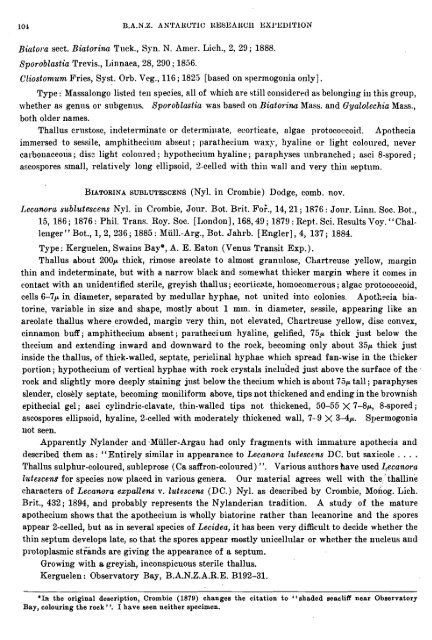Create successful ePaper yourself
Turn your PDF publications into a flip-book with our unique Google optimized e-Paper software.
Biatora sect. Biatorina Tuck., Syn. N. Arner. Lich., 2, 29; 1888.<br />
Sporoblastia Trevis., Linnaea, 28, 290 ; 1856.<br />
(!lioston~unz Fries, Syst. Orb. Veg., 116; 1825 [based on spermogoriia only].<br />
Type : Massalongo listed tell species, all of which are still coi~sidered as belonging iii this group,<br />
whether as genus or subgenus. Sporoblastia was based on Biatorina Mtiss. and Gyulolechia Mass.,<br />
both older names.<br />
Thallus crustosc, irideterminatc or determiiiate, ecorticate, algae protococlcoid. Apothecia<br />
immersed to sessile, amphithecium abseiit; parathecium waxy, hyaline or light coloured, never<br />
carbonaceo~s ; dis: light colou~ed ; hypothecium hyaline ; paraphyses unbranched ; asci 8-spored ;<br />
ascospores small, relatively long ellipsoid, 2-celled with thin wall and very thin septum.<br />
BIA~RINA SUDLUTESCENS (Nyl. in Crombie) Dodge, comb. nov.<br />
Lecunoru sublutescens Nyl. in Crombie, Jour. Bot. Brit. Foi.., 14,21; 1876 : Jonr. Linn. Soc. Bot.,<br />
15, 186 ; 1876 : Phil. Trans. Roy. Soc. [London], 168,49 ; 1879 : Rept. Sci. Results Voy. "Chal-<br />
lenger" Bot., 1, 2, 236 ; 1885 : Mull.-Arg., Bot. Jahrb. [Engler] , 4, 137 ; 1884.<br />
Type : Kerguelen, Swains Bay*, A. E. Eaton (Venus Transit Exp.).<br />
Thallus about 200~ thick, rimose areolate to almost granulose, Chartreuse yellow, margin<br />
thin and indeterminate, but with a narrow- black and somewhat thicker margi~i where it comes in<br />
contact with an unidentified sterile, greyish thallus; ecorticate, homoeomcrous ; algae protococcoid,<br />
cells 6-7~ in diameter, separated by medullar hyphae, not united into colonies Apoti;ecia biatorine,<br />
variable in size and shape, mostly about 1 mm. in diameter, sessile, appearing like an<br />
areolate thallus where crowded, margin -iery thin, not elevated, Chartreuse yellow, disc convex,<br />
cinnamon buff; amphithecium absent ; pmathecium hyaline, gelified, 75,~ thick just below the<br />
thecium and extending inward and downward to the rock, becoming only about 35r thick just<br />
inside the thallus, of thick-walled, septate, periclinal hyphae which spread fan-wise in the ihicker<br />
portion; hypothecium of vertical hyphae with rock crystals includ~d just above the surface of the<br />
rock and slightly more deeply staining just below the thecium which is abont 75r tall ; paraphpses<br />
slender, closely septate, becoming moniliform above, tips not thickened and endingin the brownish<br />
epithecial gel; asci cylindric-clavate, thin-walled tips not thickened, 50-55 X 7-&, 8-spored;<br />
ascospores ellipsoid, hyaline, 2-celled with moderately thickened wall, 7- 9 X 34~. Spermogonia<br />
iiot seen.<br />
Apparently Nylander and.Muller-Argau had only fragments with imn~ature ayothecia and<br />
described them as: "Entirely similar i11 appearance to Lecanora lutescens DC. but saxicole . . . .<br />
Thallm sulphur-coloured, subleprose (Ca saffron-coloured) ". Various authors have used Lecanoru<br />
1utescen.t for species now placed in various genera. Our material agrees well with the thalline<br />
characters of Lecanora ezpdlens v. lutescens (DC.) Nyl. as described by Crombie, Monog. Lich.<br />
Brit., 432; 1894, and probably represents the Nylanderian tradition. A study of the mature<br />
apothecium shows that the apothecium is wholly biatorine rather than lecanorine and the spores<br />
appear 2-celled, but as in several species of Lecidea, it has been very difficult to decide whether the<br />
thin septum develops late, so that the spores appear mostly unicellular or whether the iincleus aid<br />
protoplasmic strands are giving the appearance of a septum.<br />
Crowing with a greyish, inconspicuous sterile thallus.<br />
Kerguelen: Observatory Bay, B.A.N.Z.A.R.E. B192-31.<br />
*In the original description, Crombie (1879) changes the citation to "shaded seacliff near Observatory<br />
Bay, colouring the rock". I have seen neither specimen.

















